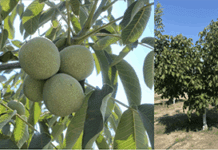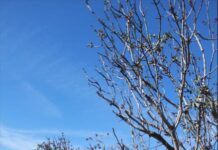
A six-year evaluation of glyphosate residues in orchard soils suggested that almond and other orchard crops are not negatively impacted by glyphosate residues in the soil, either from direct herbicide effects or micronutrient deficiencies.
The evaluation was conducted in response to a number of questions from growers concerned about the possibility of glyphosate chelating soil micronutrients and leading to deficiencies. Additionally, some were concerned that repeated glyphosate applications could cause direct impact to the trees from accumulation in the soil.
When Brad Hanson, UCCE specialist in the Department of Plant Sciences at UC Davis and project collaborator, started getting these questions and concerns from growers, he was skeptical. “I never really thought it made a lot of sense at real-world scale,” he said. “But we decided if I got the question very many times, then it’s something we should look into.”
The Almond Board of California and California Dried Plum Board helped fund the project at the UC Davis Plant Sciences Field Facility in Davis. The project tested glyphosate impacts on three orchard crops: almond (Nonpareil on Lovell), prune (Improved French on Lovell) and cherry (Coral on Emla-Colt).
Hanson noted that glyphosate treatments in each experimental orchard system were much higher than the industry standard. “The highest rate was about a gallon of RoundUp PowerMAX [per treatment], well above a normal application rate, and that was applied three times per year for six years in a row.”
Hanson and other researchers even amended half of the tree sites with coarse sandy soil in an attempt to set up a “worst case scenario” for any negative impact on micronutrient levels and/or trees via glyphosate residues. In the first two years after planting, some of the treatments received a water drench immediately after each glyphosate treatment in an effort to drive the herbicide into the root zone. Even in these conditions, no negative effects were observed on the trees.
“We just didn’t see that [impact] with three different tree species,” Hanson said, acknowledging that there is still a possibility that glyphosate residues can have a negative impact on trees in certain situations. “It doesn’t prove that there can’t be [negative impacts], but this was a pretty extreme scenario, so if there’s a likelihood for that to have happened, I feel like we gave it a chance.”
Micronutrient impacts of glyphosate residue in soil is a “numbers game,” according to Hanson, meaning that each glyphosate molecule can only bind to one micronutrient molecule. So, even if there is some micronutrient chelation occurring, Hanson said that with normal applications of glyphosate, the amount of micronutrient molecules would vastly outnumber that of glyphosate.
“It’s probably not likely to be at a sufficient level to have a biological impact on tree growth, mostly because we’re not in a nutrient-short environment where we grow tree crops,” he said.
To read more about the evaluation, the full report can be accessed here.
















